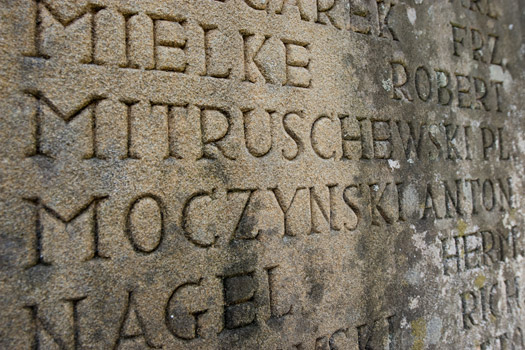
Von Einwanderern bleiben die Namen
Die meisten Namenstafeln des Wittringer Ehrenmals sind verwittert, die Namen unleserlich. Dennoch kann man noch einige Namen entziffern und die Namensvielfalt wird deutlich. Da die Männer als Deutsche ihren Wehrdienst leisten mussten, zeigen nur die Nachnamen der Gefallenen ihre polnische oder masurische Herkunft an.
© Foto Dietrich Hackenberg
Leute zurück zur Auswahl
Memorials in the Ruhr Region The names of immigrants remain
In the 19th Century industrialization period, the Ruhr Region became a popular destination for immigrants in light of industrialization. People came from different regions in Germany, but also from what is now Poland, the Czech Republic and Slovakia. Workers were specifically recruited by the mines and iron works; work force directories were maintained which were preserved along with registry information regarding immigrants and their families. Many streets and city districts in the cities of the Ruhr Region are reminiscent of the large waves of immigration the area experienced, with their old tenant-occupied buildings and settlements. However, very few traces of im-migrants as individuals remain. Mainly because a large portion of the immigrants were unskilled labourers and tradesmen who arrived without any property to speak of; indeed many were penniless. In general, they were not in a position to finance their own memorials or make longterm investments in family plots.
The lack of remaining personal legacies was also due to the political practices in the German Reich during the Wilhemine period 1871-1918. Most Polish speaking people originated from the Posen Province and West Prussia, which were, at the time, located in the territory of the German Reich, and, for this reason, held German citizenship. Again all attempts to create a Polish state were suppressed. For this reason, the Polish speaking community was strictly regulated and monitored.
However, even today, several traces remain of immigrants from that time: specifically, their names. Surnames that originate from Slavic languages have remained an attribute of the Ruhr Region to this day; this is evident in the great diversity of names of the fallen soldiers from both World Wars found on public war memorials. Prior to 1918 men had to serve in the military as Germans due to the way borders were delineated, so it is only the surnames of the fallen that reveal their Polish or Masurian origins. The fact that they all had German or Germanised given names goes back to the practices of the registry office at the time, which required that a person’s legal (given) name be German. One example of this is the memorial in the Wittringer City Forest in Gladbeck, which was erected in 1934; most of the nameplates on the Wittringer memorial are weather-beaten and the names illegible. However, the names were made public in the Gladbecker Blättern, during the First World War, in four so-called “Honour Roll for Fallen Heroes”.Thereafter, a total of 1,430 Gladbeck residents died as soldiers on the fronts in the First World War of which thirty percent were of Polish origin.
Among the war memorials maintained by the churches, the one found in the Evan-gelical Church of Christ in Gelsenkirchen-Bismark stands out both historically and artistically. The fallen of 1914-1918 are commemorated by four large, pointed arch niches. More than one third of the names are of Masurian origin.
An additional group of memorials were erected for the miners, who were killed in min-ing accidents; in Bockum-Hövel, for example. In 1908, one of the worst mining accidents in the German coalmining industry occurred in the Radbod mine, where 348 miners were killed. Since 1911, a memorial, designed by Professor Ernst Müller from Braunschweig, and located in the Bockum-Hövel cemetery, remembers the dead. The plaques bearing the names of the dead reveal the large percentage of Polish people who made up the workforce in the Radbod mine.
Denkmale zum Impuls
Gladbeck - Ehrenmal im Wittringer Stadtwald
In den 1920er Jahren entstand im Wittringer Wald ein fußläufig erreichbares ... weiter
Hamm - Ehrenmal für das Grubenunglück auf Zeche Radbod
Auf der 1905 abgeteuften Zeche Radbod nordwestlich von Hamm kam es am 12. November 1908 kurz ... weiter
